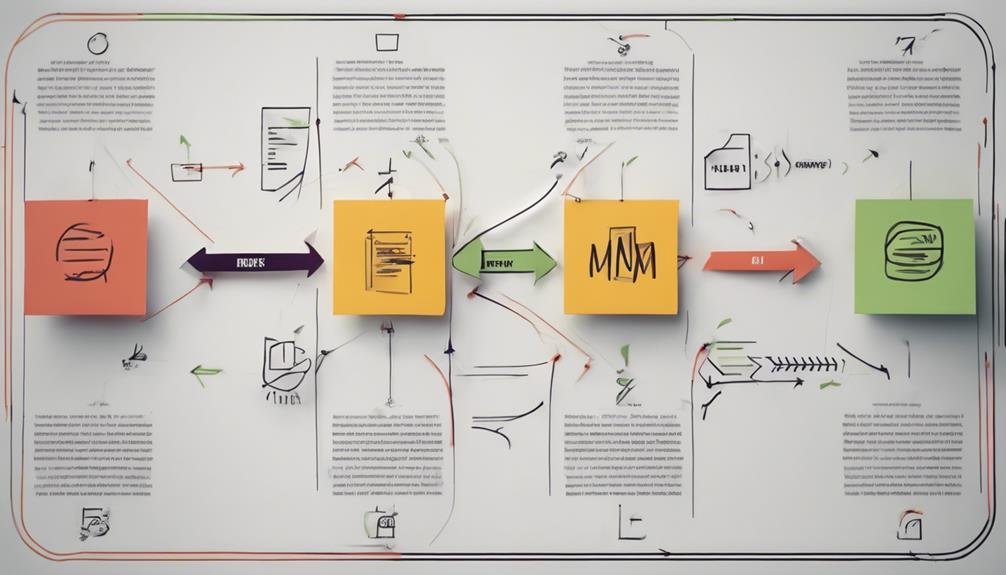Business Process Mapping Essentials
In the realm of organizational efficiency and optimization, business process mapping stands as a critical tool for streamlining operations and enhancing productivity.
The intricacies of mapping out processes, identifying bottlenecks, and visualizing workflows can often be the differentiating factor between success and stagnation in today's competitive landscape.
As businesses navigate the complexities of modern markets, understanding the fundamentals of process mapping becomes not just advantageous but imperative.
The journey of dissecting and reconstructing operational blueprints to achieve heightened effectiveness is a voyage worth embarking upon for any forward-thinking entity.
Key Takeaways
- Identify activities, sequence tasks, detail inputs, and highlight decision points for effective process mapping.
- Engage stakeholders, enhance communication, and drive workflow improvements through collaborative mapping sessions.
- Choose suitable mapping techniques, tools, and prioritize user experience to align with organizational goals.
- Ensure clarity, consistency, and stakeholder buy-in while analyzing workflows, identifying bottlenecks, and implementing process improvements.
Importance of Process Mapping
Process mapping plays a crucial role in identifying inefficiencies, improving transparency, and enhancing overall organizational performance. By visually representing each step of a process, businesses can pinpoint areas where improvements are needed, leading to enhanced efficiency and streamlined operations. Analyzing the current workflow through process mapping allows organizations to identify redundant tasks, unnecessary delays, and bottlenecks that may hinder productivity. This structured approach enables businesses to make informed decisions on how to optimize their processes, allocate resources effectively, and enhance the overall quality of their outputs.
Improving efficiency is a key outcome of process mapping, as it allows for a more streamlined approach to operations. By clearly outlining the sequence of activities and decision points within a process, organizations can identify opportunities for automation, standardization, and elimination of non-value-added steps. This not only reduces the time and resources required to complete tasks but also ensures that processes are executed consistently and in alignment with organizational goals. Ultimately, process mapping serves as a foundation for continuous improvement efforts, driving operational excellence and sustainable growth within an organization.
Benefits of Visual Representation
How can visual representation enhance the communication and understanding of complex processes within an organization?
Visual representation in business process mapping offers a clear and concise way to convey intricate processes, making it easier for stakeholders to grasp the workflow. By utilizing visual elements such as flowcharts, diagrams, and symbols, organizations can streamline the communication of processes, leading to improved understanding among team members. This enhanced clarity reduces the chances of misinterpretation and ensures that everyone is on the same page regarding the procedures and tasks involved.
Moreover, visual representation in process mapping contributes to increased efficiency within the organization. When employees can visually see the steps involved in a process, they can identify bottlenecks, redundancies, or areas for improvement more easily. This transparency allows for targeted enhancements to be made, ultimately optimizing workflows and increasing overall productivity.
Key Components of Process Maps
Process maps serve as a visual representation of the steps involved in a particular business process. They help in clearly outlining the sequence of actions, responsibilities, and decisions within the process.
Process Steps
An integral aspect of creating effective process maps is outlining the sequential steps involved in the workflow to ensure a clear and systematic representation of the business process. When documenting process steps, consider the following key components:
- Identify Activities: Define individual tasks or actions within the process.
- Sequence Tasks: Arrange activities in a logical order to depict the flow of work.
- Detail Inputs and Outputs: Specify what is required to start a task and what is produced as a result.
- Highlight Decision Points: Identify points where choices are made to optimize the process.
Flow Visualization
In the realm of business process mapping, a fundamental element that plays a crucial role in conveying the workflow effectively is the visualization of flow through key components within process maps. Flow visualization allows for a clear understanding of how tasks are interconnected, the sequence in which they occur, and where potential bottlenecks may arise.
Choosing the Right Mapping Technique
Effective business process mapping hinges on selecting the most appropriate tools and understanding the intricacies of process flow. By carefully considering the mapping techniques available and grasping the nuances of how processes unfold, organizations can create comprehensive and insightful process maps.
This strategic approach ensures that the chosen mapping technique aligns seamlessly with the specific needs and goals of the organization.
Selecting Mapping Tools
Selecting the appropriate mapping tool is a crucial step in ensuring the accuracy and effectiveness of the business process mapping technique employed. When choosing a mapping tool, consider the following:
- Comparison: Evaluate different tools available in the market to understand their strengths and weaknesses.
- Features: Look for tools that offer the specific features required for your business process mapping needs.
- User Experience: Prioritize tools that are user-friendly and intuitive to enhance the mapping process.
- Customization: Opt for tools that allow customization to tailor the mapping technique to your organization's unique requirements.
Understanding Process Flow
Understanding the process flow is fundamental to selecting the right mapping technique for accurately representing the intricacies of business operations. Efficiency in operations hinges on a clear depiction of how tasks are interconnected and how they flow from one to the next. By understanding the process flow, organizations can identify bottlenecks, redundancies, and areas for improvement, thus optimizing operations.
Different mapping techniques, such as flowcharts, swimlane diagrams, or value stream maps, offer varying levels of detail and focus. Flowcharts are ideal for illustrating sequential processes, swimlane diagrams for showing responsibilities within processes, and value stream maps for visualizing the end-to-end flow of materials and information. Choosing the appropriate technique based on the specific needs of the process is crucial for effective business process mapping.
Steps to Create Effective Process Maps
To develop comprehensive process maps that accurately depict the workflow of a business, it is essential to begin by identifying key stakeholders and gathering relevant data on each step of the process. When creating effective process maps, consider the following steps:
- Utilize Various Mapping Techniques: Choose the appropriate mapping technique based on the complexity and nature of the process. Techniques like swimlane diagrams, flowcharts, and value stream maps can offer different perspectives on the workflow.
- Focus on Process Improvement: While mapping out the current state of the process, analyze each step critically to identify bottlenecks, redundancies, or inefficiencies. This analysis sets the foundation for process improvement initiatives.
- Ensure Clarity and Consistency: Use standardized symbols and terminology to ensure that the process map is easily understood by all stakeholders. Consistency in representation is key to effective communication.
- Validate with Stakeholders: Once the process map is drafted, validate it with key stakeholders to ensure accuracy and alignment with the actual workflow. Incorporate feedback for refinement and completeness.
Engaging Stakeholders in Mapping
Engaging stakeholders in the process mapping phase is vital for ensuring that all perspectives and insights are considered. By emphasizing stakeholder input importance, businesses can align processes with organizational goals and address potential bottlenecks effectively.
Collaborative mapping sessions can facilitate open communication, leading to a comprehensive and accurate representation of the business processes.
Stakeholder Input Importance
Effective business process mapping necessitates active involvement and input from key stakeholders to ensure comprehensive understanding and alignment with organizational goals. Engaging stakeholders in the mapping process is crucial for successful implementation and sustainable improvements. To ensure effective stakeholder input, organizations should consider the following:
- Clear Communication Channels: Establish transparent communication strategies to keep stakeholders informed and engaged throughout the mapping process.
- Identifying Key Stakeholders: Identify and involve all relevant stakeholders to gather diverse perspectives and insights.
- Setting Clear Objectives: Define clear objectives for stakeholder engagement to ensure alignment with the mapping goals.
- Feedback Mechanisms: Implement feedback mechanisms to incorporate stakeholder input and address any concerns or suggestions promptly.
Collaborative Mapping Sessions
In order to foster a collaborative approach to business process mapping, engaging stakeholders in interactive sessions is imperative for capturing diverse perspectives and driving alignment with organizational objectives.
Group brainstorming allows for the collective input of stakeholders, promoting a more comprehensive understanding of the processes at hand.
Through interactive mapping sessions, team collaboration is enhanced as participants actively contribute to visualizing processes, identifying inefficiencies, and proposing improvements.
This collaborative effort not only increases stakeholder buy-in but also ensures that the mapping accurately reflects the operational reality.
Analyzing and Improving Workflows
A critical aspect of optimizing operational efficiency within an organization involves the detailed analysis and enhancement of workflows. To effectively analyze and improve workflows, the following steps are essential:
- Identifying Bottlenecks: Pinpoint areas within the workflow where processes slow down or get stuck, causing delays and inefficiencies.
- Streamlining Processes: Simplify and restructure steps to eliminate redundancies and unnecessary complexities, ensuring a smoother flow of tasks.
- Implementing Automation: Integrate automation tools where feasible to reduce manual intervention, minimize errors, and expedite repetitive tasks.
- Regular Performance Monitoring: Continuously track key performance indicators related to workflow efficiency, allowing for timely adjustments and improvements.
Implementing Process Mapping Tools
Utilizing specialized software applications is instrumental in efficiently implementing process mapping tools within an organizational framework. These tools enable seamless tool integration, allowing for the visualization of existing processes and the identification of bottlenecks or inefficiencies. By utilizing process mapping software, organizations can streamline operations and enhance process optimization by reengineering workflows based on the insights gained.
Moreover, these tools facilitate data analysis by providing a visual representation of how tasks are interconnected, allowing for a comprehensive understanding of the workflow. This data-driven approach enables informed decision-making and targeted improvements to enhance overall performance within the organization. Additionally, process mapping tools aid in performance measurement by establishing key performance indicators (KPIs) that can be tracked and evaluated over time. This ensures that processes are continuously monitored and refined to meet organizational objectives effectively.
Ensuring Sustainability and Scalability
To establish long-term effectiveness and adaptability, it is imperative for organizations to focus on the sustainability and scalability of their implemented process mapping strategies. When looking at sustainability strategies and scalability challenges, organizations must consider the following:
- Continuous Evaluation: Regularly assess the effectiveness of the process mapping strategies to identify areas for improvement and ensure alignment with organizational goals.
- Flexibility in Design: Build processes that can adapt to changing business environments and requirements, allowing for scalability without the need for complete overhauls.
- Employee Training and Engagement: Invest in training programs to ensure that employees understand and can effectively use the process mapping tools, fostering a culture of continuous improvement.
- Integration with Technology: Leverage automation and digital tools to streamline processes, increase efficiency, and facilitate scalability while reducing the risk of errors.
Case Studies and Success Stories
Examining real-world case studies and success stories provides valuable insights into the practical application and outcomes of business process mapping strategies. By delving into real-world applications and industry examples, we can uncover the practical implications and success factors that contribute to the effectiveness of business process mapping.
| Real-World Case Studies | Success Factors |
|---|---|
| Company A implemented a new BPM system resulting in 20% cost reduction | Strong leadership support |
| Organization B utilized process mapping to streamline operations and improve customer satisfaction | Employee training and engagement |
| Firm C integrated BPM to enhance cross-departmental communication, leading to increased productivity | Clear communication channels |
| Business D adopted process mapping to identify bottlenecks and optimize resource allocation | Data-driven decision-making |
| Enterprise E leveraged BPM to achieve ISO certification, ensuring quality standards | Continuous monitoring and improvement |
These examples showcase how businesses across various industries have successfully utilized business process mapping to drive efficiency, enhance customer experiences, and achieve strategic goals. By studying these cases, organizations can learn valuable lessons and apply similar strategies to improve their own processes.
Conclusion
In the intricate web of business operations, process mapping acts as a guiding compass, illuminating the path towards efficiency and optimization. Like a skilled cartographer, organizations must meticulously chart their workflows, ensuring every step is clear and purposeful.
By embracing the art of process mapping, businesses can navigate through the labyrinth of complexities, unlocking hidden treasures of productivity and success. Just as a map reveals the terrain ahead, process mapping unveils the landscape of possibilities for sustainable growth and scalability.







